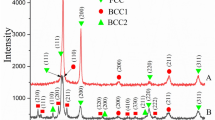Abstract
Molybdenum disilicide was synthesized from elemental reactants in argon and vacuum atmospheres by utilizing the exothermicity of the reaction using self-propagating high temperature synthesis. Experiments were carried out using powdered reactants and compacts with varying densities. The reaction front propagated at a finite velocity depending upon the atmosphere, the diameter of the pellet and the particle sizes of the reactants. The exothermicity of the reaction between molybdenum and silicon raised the temperature of the product to 1886 K, which is close to the theoretical adiabatic combustion temperature, 1900 K. X-ray diffraction analysis of the product confirmed the product to be a single phase MoSi2 crystallizing in a tetragonal structure. Microstructural examination revealed melting of Si and its capillary flow, and chemical analysis indicated that the product is much purer than the reactants.
Similar content being viewed by others
References
J. E. Spice andL. A. K. Staveley,J. Soc. Chem. Ind. 68 (1949) 313.
Idem, ibid. 68 (1949) 348.
F. Booth,Trans. Farad. Soc. 49 (1953) 272.
A. G. Merzhanov andI. P. Borovinskaya,Dokl. Akad. Nauk. S.S.S.R. 204 (1972) 366.
Idem, Comb. Sci. Tech. 10 (1975) 195.
W. L. Frankhouser, K. W. Brendley, M. C. Kieszek andS. T. Sullivan, “Gasless Combustion Synthesis of Refractory Compounds” (Noyes, New Jersey, 1985) pp. 3–79.
In Proceedings of DARPA/Army Symposium on Self-Propagating High Temperature Synthesis, Daytona Beach, Florida, October 1985 (US Government Printing Press, USA).
J. B. Holt andZ. A. Munir,J. Mater. Sci. 21 (1986) 251.
P. D. Zavitsomos andJ. R. Morris, Jr.,Proc. Ceram. Engng Sci. (1984) 625.
“Coatings of High Temperature Materials”, edited by H. H. Hausner (Plenum, New York, 1966).
J. Pare andG. Elkund,Met. Prog. (1978) 32.
J. Schlichting,High Temp.-High Press.10 (1978) 241.
“Kanthal Super Electric Heating Elements” (Kanthal Corporation, Bethel, Connecticut) (USA).
J. Milne, “Instant Heat” (Kinetic Metals, Inc., Derby, Connecticut, 1985).
D. H. Killeffer andA. Linz, “Molybdenum Compounds: Their Chemistry and Technology” (Interscience, New York, 1952).
R. Wehrman, in “High Temperature Materials and Technology”, edited by I. E. Campbell and E. M. Sherwood (Wiley, New York, 1967) pp. 399–430.
B. Aronsson, T. Lundstrom andS. Rundquist, “Borides, Silicides and Phosphides” (Wiley, New York, 1965).
D. A. Robins andI. Jenkins, in “Plansee Proceedings”, edited by P. Benesovsky (1955).
D. A. Robins andI. Jenkins,Acta Metall. 3 (1955) 598.
P. Grievson andC. B. Alcock, in “Special Ceramics”, edited by P. Popper (Academic, New York, 1960).
A. R. Sarkisyan, S. K. Dolukhanyan, I. P. Borovinskaya andA. G. Merzhanov,Fizika Goreniya i Vzryva 14 (1978) 49.
Powder Diffraction Files, File 6-0681 (International Joint Committee on Powder Diffraction Standards, Philadelphia, USA, 1988).
L. Pauling, in “Molybdenum Compounds: Their Chemistry and Technology”, edited by D. H. Killeffer and A. Linz (Interscience, New York, 1952).
G. V. Samsonov andI. M. Vinitskii, “Handbook of Refractory Compounds”, translated from the Russian by K. Shaw (IFI/Plenum, New York, 1980) p. 105.
G. V. Samsonov, “Suicides and their uses in Engineering” (Akad. Nauk. Ukr. SSR, Kiev, 1959) p. 44, pp. 106–112.
I. E. Campbell andE. M. Sherwood, “High Temperature Materials and Technology” (Wiley, New York, 1967) p. 401.
S. P. Murarka, “Silicides for VLSI Applications” (Academic, New York, 1983) pp. 29–131.
R. Henne andW. Weber,High Temp.-High Press.18 (1986) 223.
L. Brewer, R. H. Lamoreaux, R. Ferro, R. Marazza andK. Girgis, “Molybdenum: Physico-Chemical Properties of its Compounds and Alloys”, edited by L. Brewer (International Atomic Energy Agency, Vienna, 1980).
Author information
Authors and Affiliations
Rights and permissions
About this article
Cite this article
Deevi, S.C. Self-propagating high-temperature synthesis of molybdenum disilicide. J Mater Sci 26, 3343–3353 (1991). https://doi.org/10.1007/BF01124683
Received:
Accepted:
Published:
Issue Date:
DOI: https://doi.org/10.1007/BF01124683




